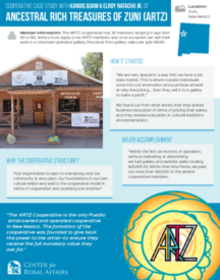Para la versión en español, por favor oprima aqui.
Location: Zuni, New Mexico
Member information: The ARTZ cooperative has 32 members ranging in age from 20 to 80. Artists must apply to be ARTZ members and once accepted can sell their work in a volunteer-operated gallery. Proceeds from gallery sales are split 60/40.
How it started
“We are very special in a way that we have a job ware market. This is where outside individuals come into our reservation and purchase artwork at very low pricing... then they sell it to a gallery to make a profit.”
We found out from other artists that they lacked business education in terms of pricing their wares, and they needed education in cultural traditions and preservation.
Why the cooperative structure?
“Our organization is open to everybody, and our community is very open. Our foundations in our own culture relate very well to the cooperative model in terms of cooperation and assisting one another.”
Major accomplishment
“Within the first six months of operation,
without marketing or advertising,
we had gallery and website sales totaling $20,813.35. Within that time frame, we paid out more than $12,000 to the artists/cooperative members.”
Q: Is there anything that you believe sets your cooperative apart from others or makes it more successful?
A: With our membership fairly
big... we started to lean on one another and create a family within ourselves. This has helped with a lot of the backbone of the cooperative.
We also do all the paperwork, so the artists/members don’t have to handle any of that and can just focus on their art.
Q: What were some of the things that went into figuring out how to market your cooperative?
A: We had nothing in terms of marketing to start out (no website, no Facebook page, etc.). We were very fortunate that our members had clients we could tell about the opening of the cooperative. It all spread by word of mouth and was very successful. We now have a website, Instagram, a Facebook page, and other marketing strategies.
Potential Cooperative
Pitfalls to Avoid
- Lack of clearly identified mission
- Inadequate planning
- Failure to use experience advisers and consultants
- Lack of member leadership
- Lack of member commitment
- Lack of competent management
- Failure to identify and minimize risks
- Poor assumptions
- Lack of financing
- Inadequate communication
This project was developed using a U.S. Department of Agriculture Rural Development Socially Disadvantaged Groups Grant. The Center for Rural Affairs is an equal opportunity provider and employer.


